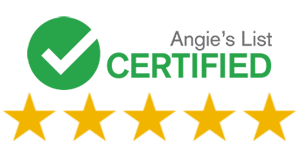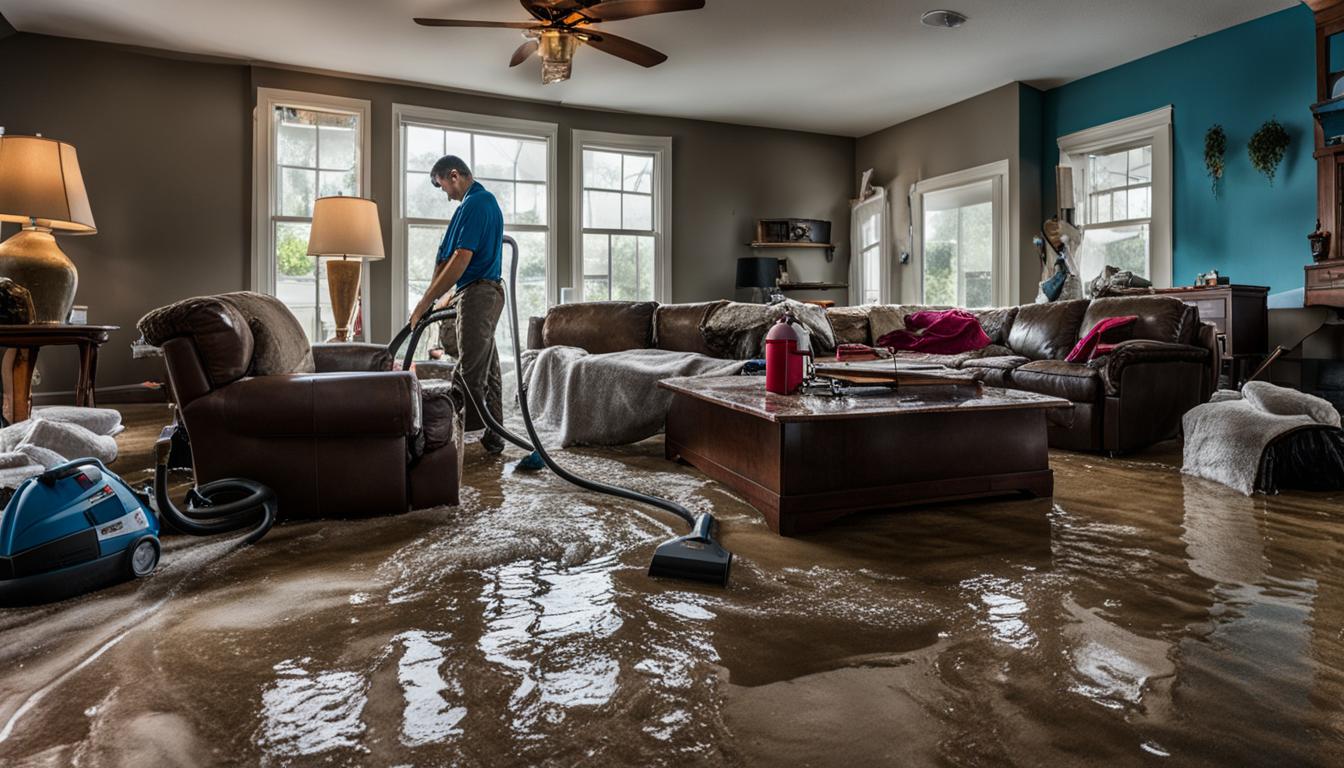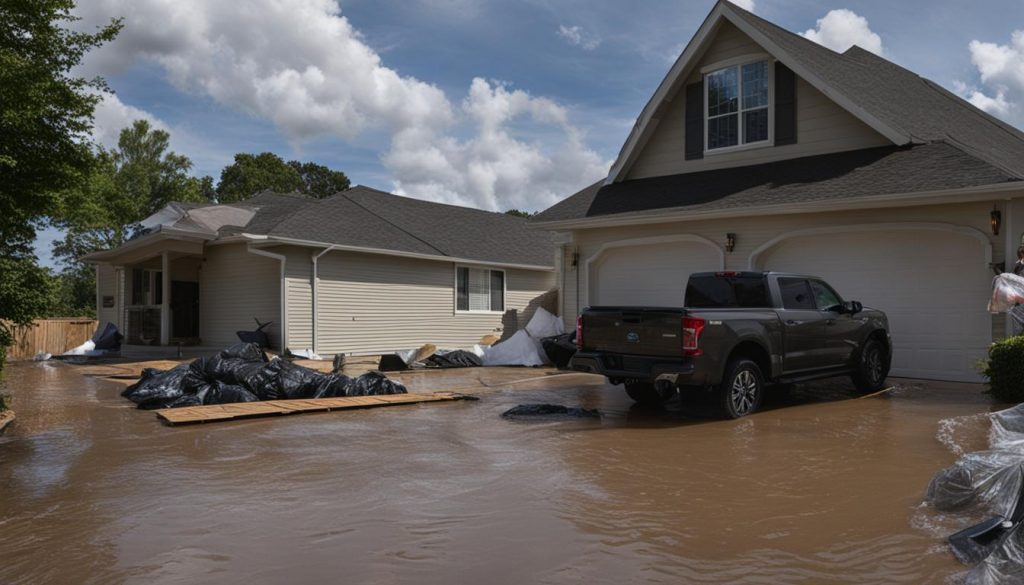Dealing with water damage in your house can be a stressful and overwhelming experience. Whether it’s from a burst pipe, a leaky roof, or a flooded basement, it’s essential to take immediate action to minimize further damage and restore your home to its pre-damaged condition. In this guide, we’ll walk you through the necessary steps to clean your house from water damage and ensure a thorough restoration.
Key Takeaways:
- Locate the source of the water and turn off the power to ensure safety.
- Contact your insurance company and document the damage for a claim.
- Remove any wet items and initiate the drying process.
- Consider contacting a professional water restoration specialist for significant damage.
- Call a mold specialist if you suspect mold growth.
Locating the Source and Turning off the Power
When dealing with water damage, it is crucial to determine the source of the water. This will allow you to take appropriate action and understand whether the water is clean or contaminated. Locate the area where the water is entering your home, such as a burst pipe or a leaky roof. Once you have identified the source, take immediate steps to stop the flow and prevent further damage.
If possible, turn off the water source to halt the influx of water. This may involve shutting off the main water valve or turning off individual fixtures. By stopping the flow, you can minimize the extent of the damage and begin the cleanup process.
In situations where there is significant flooding, it is essential to prioritize safety by turning off the power. Water and electricity are a dangerous combination that can lead to electrocution or fires. If your electrical outlets or appliances are underwater, do not attempt to turn off the power yourself. Instead, contact your utility company to have the electricity disconnected.
After the water has been removed from your home, it is advisable to call in an electrician to inspect the wiring and ensure that it is safe to restore power. Water can damage electrical systems, leading to potential hazards if not addressed properly.
Steps to locate the source of water damage and turn off the power:
- Identify the area where water is entering your property.
- Take immediate steps to stop the flow of water by turning off the water source.
- In cases of significant flooding, contact your utility company to turn off the power.
- After the water removal process, consult an electrician to inspect the wiring before restoring power.
In order to provide visual context, refer to the image below which illustrates the importance of locating the water source and turning off the power when dealing with water damage:
| Importance of Locating the Water Source and Turning off the Power |
|---|
| Minimizes further water damage by stopping the flow |
| Prevents electrical hazards and reduces the risk of electrocution or fires |
| Enables safe restoration of power after the water is removed |
Calling the Insurance Company and Starting the Claim Process
When you’re dealing with water damage in your home, one of the first steps you should take is to contact your homeowner’s insurance company. Starting the insurance claim process as soon as possible is crucial to ensure timely coverage for the damages. While not all types of water damage are covered by insurance, you may be eligible for coverage in cases of sewage backup or plumbing problems.
When you call your insurance company, be prepared to provide them with details about the water damage and how it occurred. You can also inquire about the specific coverage and deductible amounts associated with water damage claims. This information will help you understand the financial aspect of the claim and any out-of-pocket expenses you may be responsible for.
Documenting the water damage is an important part of the insurance claim process. Before you start cleaning up or making any repairs, it’s essential to take photos or videos of the affected areas. These visual records will serve as evidence for the insurance adjuster to assess the extent of the damage. Make sure to capture the waterlogged items, affected structures, and any visible signs of mold growth.
Your insurance company may also be able to provide recommendations for mold remediation specialists or water damage repair professionals in your area. Trusted professionals who specialize in water damage restoration can help assess the situation accurately and provide expert advice on the necessary repairs and cleanup efforts. Allklean Carpet Cleaning and Restoration can help you if you are in the Washington state or Idaho area. We have years of experience with cleaning homes from water damage.
Insurance Claim Documentation Checklist:
| Items to Document | Methods |
|---|---|
| Affected Areas and Structures | Take clear photos or record videos to capture the extent of the damage. |
| Waterlogged Items | Photograph individual items, focusing on their condition and level of saturation. |
| Mold Growth | Document any signs of mold growth, including discoloration and musty odors. |
By promptly calling your insurance company and documenting the water damage, you can take the necessary steps towards a successful insurance claim. Remember to keep all communication and documentation organized for easy reference throughout the claim process. This will help ensure a smoother and more efficient resolution to your water damage restoration needs.
Removing Wet Items and Initiating the Drying Process
After ensuring your safety, it’s crucial to remove any wet items from the affected area as quickly as possible. The faster you remove moisture, the lower the risk of mold growth. Some items may be salvageable with proper drying and cleaning, while others may need to be discarded. To expedite the drying process, consider the following steps:
- Leave large appliances in place: If your large appliances, such as refrigerators or washing machines, were affected by water damage, it’s best to leave them in place and seek advice from an electrician on their safety.
- Promote air circulation: Open windows and doors to allow fresh air to flow through the space. This helps evaporate moisture and prevent the buildup of stagnant air.
- Use fans: Utilize fans strategically to improve air circulation and encourage faster drying. Position them to maximize airflow and direct them towards areas with high moisture content.
- Dehumidifiers: Consider using dehumidifiers to remove excess moisture from the air. These devices extract moisture and help maintain optimal humidity levels, reducing the risk of mold growth.
By following these steps, you can effectively remove wet items and initiate the drying process after water damage. Remember to prioritize safety and consult professionals when needed.
Contacting a Water Restoration Professional
If you’re facing significant water damage in your home, it’s crucial to reach out to a professional water restoration specialist. These experts have the necessary skills, equipment, and expertise to effectively pump out the water and dry out the affected area. By hiring a professional, you can ensure the integrity of your home’s foundation and structure throughout the water removal process.
A professional water restoration specialist becomes especially valuable if you’re dealing with a large volume of water or if the drying process is taking longer than 24 hours. They have the resources and knowledge to handle extensive water damage and optimize the restoration process.
When you contact a water restoration professional, they will conduct a thorough assessment of your property and develop a customized plan to address the damage. They will utilize advanced techniques and equipment to extract the water, thoroughly dry the space, and mitigate further damage.
Keep in mind that attempting to handle extensive water damage on your own can be overwhelming and ineffective. A professional water restoration specialist will ensure a thorough cleanup, reducing the risk of mold growth and other associated issues.
By entrusting the process to a professional, you can have peace of mind knowing that your home is in capable hands. They will work efficiently to restore your property to its pre-damage condition, allowing you to focus on getting your life back to normal.
Remember, when it comes to water damage cleanup, the expertise of a water restoration professional is invaluable.
Calling a Mold Specialist
Acting quickly to remove water and dry out the space within 24 hours can help prevent mold growth. However, if the water damage persists for an extended period or if you suspect mold growth, it’s recommended to call a mold remediation specialist. These professionals can conduct a thorough inspection to identify any hidden mold and assess the overall health and safety of your household. Mold can grow in areas with unchecked moisture, including HVAC ducts and underneath flooring, so it’s important to address any potential issues.
Why is calling a mold specialist important?
When dealing with water damage, it’s crucial to understand that mold growth can start within 24-48 hours. Even if you’ve taken steps to remove the water and dry out the affected area, there could still be hidden moisture or dampness that can lead to mold infestation. Calling a mold specialist ensures a comprehensive assessment of your home, including areas that are prone to mold growth. They have the expertise and tools to detect and address mold issues effectively.
| Benefits of calling a mold specialist | Consequences of neglecting mold growth |
|---|---|
|
|
Symptoms of mold exposure
Mold can have adverse effects on your health, so it’s essential to be aware of common symptoms associated with mold exposure:
- Allergic reactions, such as sneezing, coughing, and watery eyes
- Respiratory issues, including wheezing, shortness of breath, and chest tightness
- Skin irritation, rash, or itching
- Headaches and migraines
- Fatigue and lethargy
If you or your family members experience any of these symptoms, it’s crucial to address the potential presence of mold in your home by contacting a mold specialist.
Cleaning the Space and Restoring and Rebuilding
Once the space has been emptied and dried out, it’s crucial to thoroughly clean and sanitize the area after water damage. This step is essential to ensure proper disinfection, especially if the water was contaminated. The use of appropriate cleaning products is recommended to effectively eliminate any harmful bacteria or pathogens.
If you are comfortable with do-it-yourself repairs, you can tackle tasks such as repainting or replacing damaged drywall and flooring. However, for more extensive repairs or if you want to minimize future issues, it is advisable to seek professional assistance. Professionals can provide expert advice and ensure that the restoration work is done correctly, preventing further damage or complications.
In addition to restoring the affected areas, it is essential to address any underlying issues that may have contributed to the water damage. This includes improving drainage around your home’s foundation to prevent future water accumulation. Regularly inspecting appliances, plumbing systems, and other potential sources of water damage can help identify and mitigate potential risks. Taking proactive measures can save you time, money, and the hassle of dealing with water damage in the future.
FAQ
How do I clean my house from water damage?
Cleaning your house from water damage involves several important steps. First, locate the source of the water and turn off the power for safety. Then, call your insurance company to start the claim process and document the damage. Remove any wet items and begin the drying process using fans, dehumidifiers, and open windows. If the damage is extensive, consider contacting a professional water restoration specialist. Additionally, it’s important to clean and sanitize the space and restore any damaged areas.
How do I locate the source of water damage and turn off the power?
When dealing with water damage, it’s crucial to determine where the water is coming from. This will help you take appropriate action and verify whether the water is sanitary or contaminated. If possible, turn off the water source to stop the flow. Additionally, in cases of significant flooding, it’s essential to turn off the power for safety. If your electrical outlets are submerged, contact your utility company to have the power turned off. After the water is removed, consult an electrician to inspect the wiring and appliances that may have been affected.
What should I do after locating the source and turning off the power?
After ensuring your safety, contact your homeowner’s insurance company to start the claim process. Document the damage by taking photos or videos to assist the insurance adjuster. Remove any wet items from the affected area as quickly as possible. Open windows and doors to promote air circulation, and consider using fans and dehumidifiers to expedite the drying process. If the damage is extensive or the drying process takes longer than 24 hours, it’s advisable to contact a professional water restoration specialist.
Should I contact a professional for water damage cleanup?
Depending on the extent of the water damage, it may be beneficial to contact a professional water restoration specialist. These professionals have the necessary equipment and expertise to effectively pump out and dry out the space. They can also ensure the integrity of your home’s foundation and structure during the water removal process. Hiring a professional may be especially important if you are dealing with a large amount of water or if the drying process is taking longer than 24 hours.
Do I need to call a mold specialist after water damage?
If you suspect mold growth or the water damage persists for an extended period, it’s recommended to call a mold remediation specialist. These professionals can conduct a thorough inspection to identify any hidden mold and assess the overall health and safety of your household. Mold can grow in areas with unchecked moisture, including HVAC ducts and underneath flooring, so it’s important to address any potential issues.
How should I clean and restore my space after water damage?
Once the space has been emptied and dried out, it’s important to clean and sanitize the area. Use appropriate cleaning products to ensure proper disinfection, especially if the water was contaminated. If you’re comfortable with DIY repairs, you can tackle tasks such as repainting or replacing damaged drywall and flooring. However, for more extensive repairs or if you want to avoid future issues, it’s advisable to seek professional assistance. Consider improving drainage around your home’s foundation and regularly inspecting appliances and systems to prevent future water damage.










